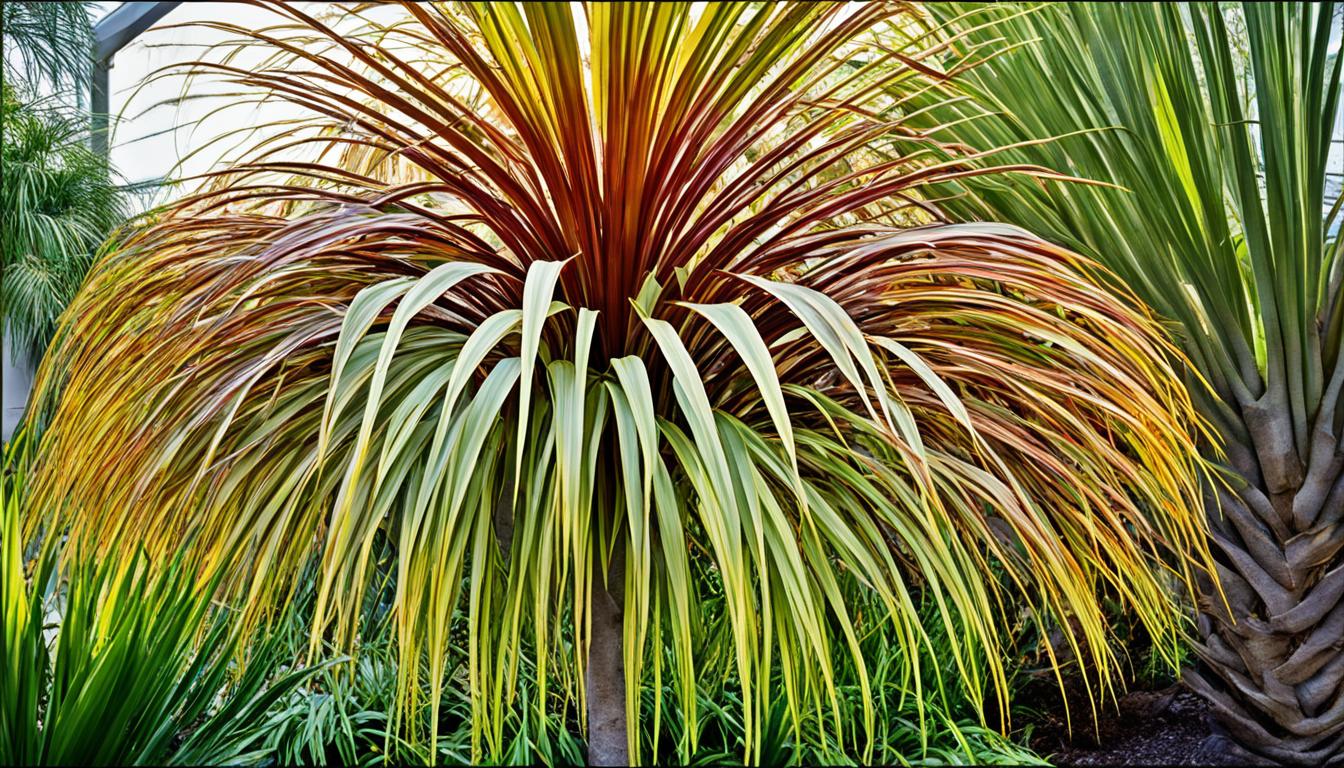Did you know the Ponytail Palm is actually a succulent? It’s also called Beaucarnea recurvata or Elephant Foot Plant. People love it because it doesn’t need much care. It also looks cool. This guide is for anyone who wants to grow it in their apartment. You’ll learn about how it cleans the air, is safe for pets, and doesn’t take up much space.
Key Takeaways:
- The Ponytail Palm is a unique and stylish indoor plant that resembles a palm tree but is actually a succulent.
- It is popular for its low-maintenance care requirements, making it a great choice for apartments.
- The Ponytail Palm has air-purifying abilities, helping to improve the indoor air quality of your apartment.
- It is generally pet-friendly, but cautious supervision is recommended to avoid accidental ingestion.
- The plant typically grows between 4-6 feet tall when kept indoors, making it suitable for small apartment spaces.
Why Do We Love the Ponytail Palm For Apartments?
The Ponytail Palm is loved for its unique look and easy care. It brings a tropical feel to indoor spaces.
Is the Ponytail Palm Air-Purifying?
The Ponytail Palm cleans the air. It removes harmful toxins and adds oxygen.
Is the Ponytail Palm Pet-Friendly?
It is safe for pets. But always watch pets around the plant.
You should also talk to a vet if you’re worried about your pets and plants.
How Big Does the Ponytail Palm Get?
In the wild, it can grow very tall. Indoors, it usually gets 4-6 feet tall.
This makes it perfect for small places. It won’t take up much room.
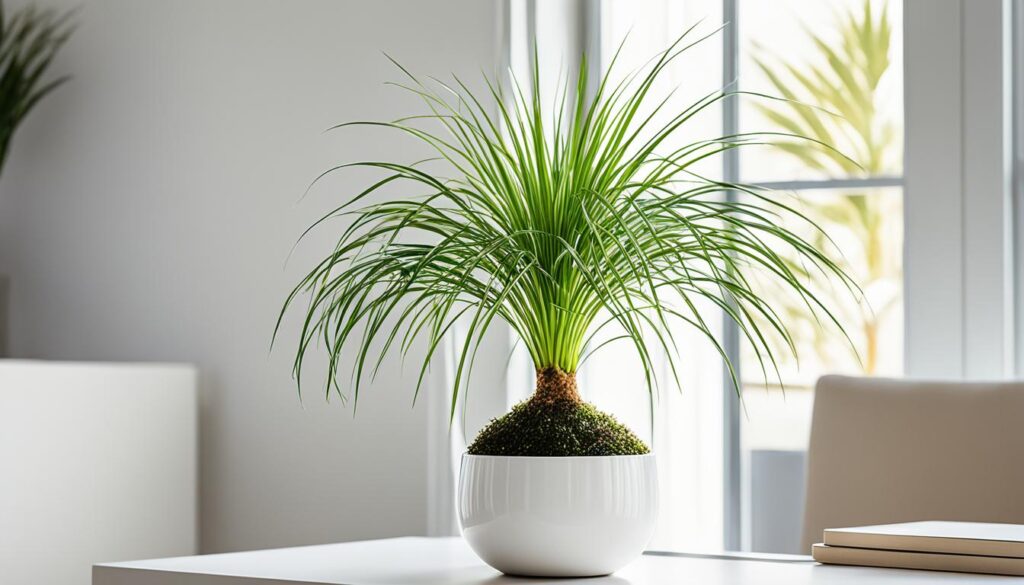
How to Grow a Ponytail Palm – Learn to Grow this Indoor Beauty
To grow a Ponytail Palm, you need to know some special tips. I’ll share how to care for it well. This includes the right pot, soil, light, water, and more. Additionally, it’s important to ensure that your Ponytail Palm is placed in a location with bright, indirect sunlight to encourage healthy growth. For watering, allow the soil to dry out completely between sessions, as overwatering can lead to root rot. If you’re also interested in maintaining a lush indoor garden, consider some parlour palm care tips, as these can complement your overall plant care routine beautifully.
Choosing the Right Pot and Soil
Choosing the right pot and soil for your Ponytail Palm is key. It loves soil that drains well and pots with holes. Use a succulent or cacti mix for best growth.
Providing Adequate Light
Light is super important for your plant. Ponytail Palms need bright, indirect light. They do well in south, east, or west windows. But, they can also grow in less light.
Watering and Humidity
This plant doesn’t need much water. Let the soil dry out before watering again. Water it every 1 to 2 weeks, checking the soil first.
Nutrition and Fertilization
Your Ponytail Palm will love occasional feeding. Use a balanced, water-soluble fertilizer in the growing season. They don’t need much, but it helps them grow.
Pruning and Maintenance
Usually, you won’t need to prune your Ponytail Palm. Just remove dead leaves sometimes. Keeping the leaves clean will help your plant stay healthy.
Propagation
You can make more Ponytail Palms two ways. Use stem cuttings or divide the plant. For cuttings, pick a healthy part, let it dry, then plant. For division, take the baby plants and put them in new pots.
Monitoring for Pests and Diseases
Watch your plant for bugs or sickness. Spider mites, mealybugs, and scale insects might show up. If they do, take care of your plant quickly.
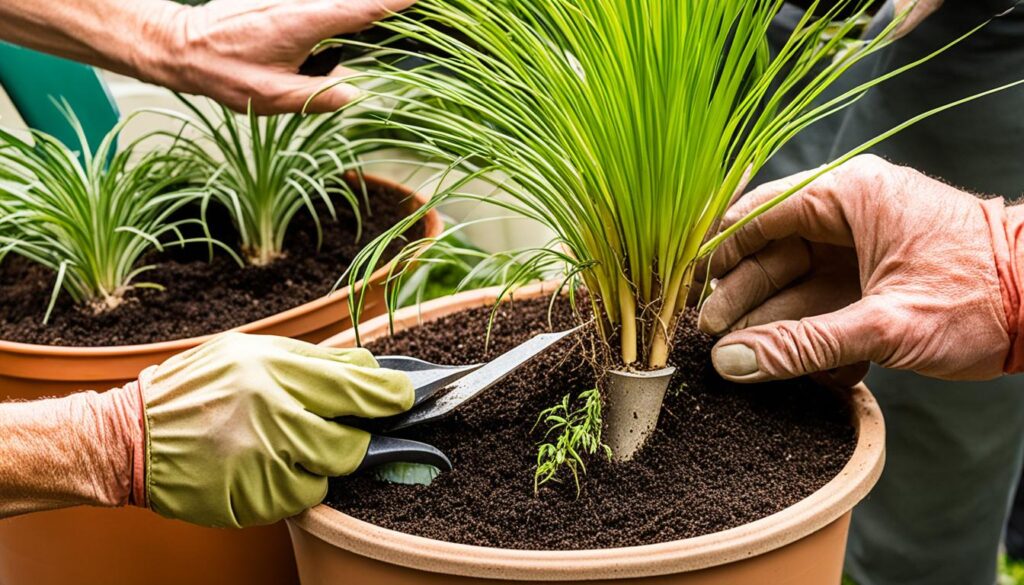
Appearance of the Ponytail Palm
The Ponytail Palm has a unique look that makes spaces more elegant. It has a big trunk that looks like an elephant’s foot. That’s why some call it “Elephant Foot Plant.”
Its long, slender leaves fall from the top, looking like a ponytail. These leaves are 2-3 feet long and go in many directions. Some may go up, twist, or curl. While some plants have many heads, most have just one.
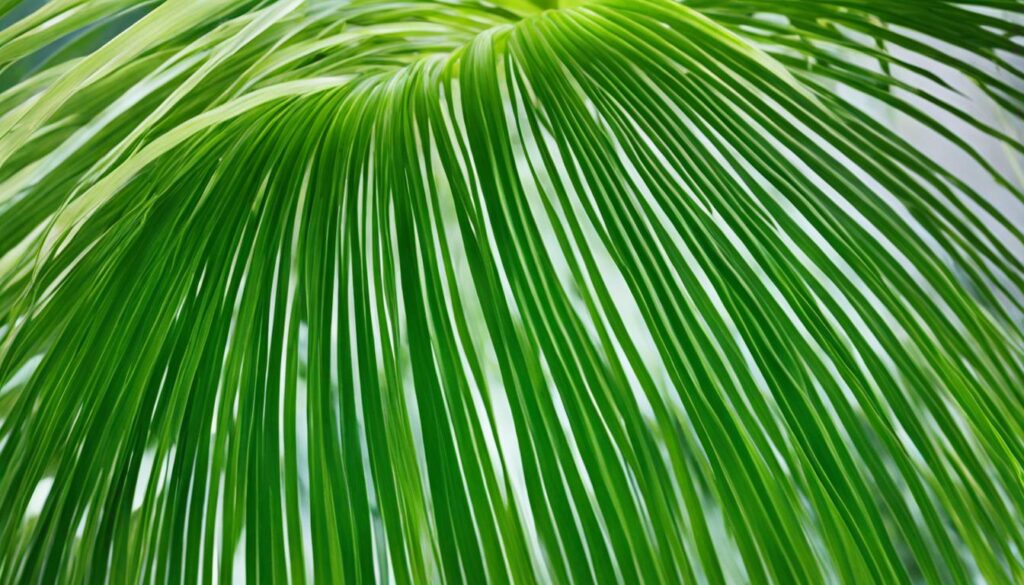
Light Requirements for the Ponytail Palm
The Ponytail Palm is a strong and flexible house plant. It does well in many kinds of light. It likes bright, indirect light but is OK in less light too. This makes it great for many spots in your house or office.
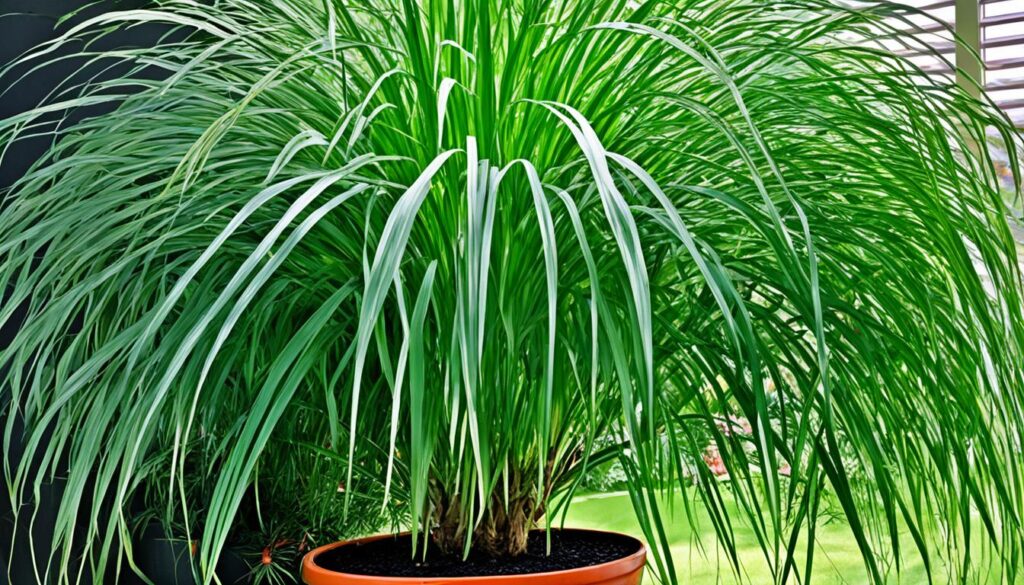
It grows best in bright, indirect sunlight. Windows that face south, east, or west are good. They give the plant plenty of light without too much direct sun.
The Ponytail Palm can also handle not having much light. It can do well in spots with less light, like north-facing windows. It might not grow fast, but it will still look good and be healthy.
Be careful not to put it in direct sun for too long. Direct sun for many hours can hurt its leaves. It’s better to keep it in a spot where it gets enough light but not too strong sun.
This plant can work with different amounts of light. You can have it in a bright place or a less bright spot. The Ponytail Palm will still be a beautiful part of your indoor space.
Watering Requirements of the Ponytail Palm
The Ponytail Palm doesn’t need much water. Knowing how much water it needs helps keep it healthy. Watering it the right way is very important for its health.
Signs of Overwatering vs. Underwatering
Knowing when it has too much or not enough water helps you care for it right.
Overwatering signs:
- Yellowing or browning leaves
- Soft or mushy trunk
- Foul smell from the soil
Underwatering signs:
- Dry and wilted leaves
- Shriveled trunk
- Soil pulling away from the edges of the pot
Stop overwatering by letting the soil dry before watering again. When to water depends on humidity and plant size. Try watering once every 1-2 weeks. But always check the soil first.
Pay attention to its watering needs. This helps you keep the right moisture balance. This will make your indoor plant look great.
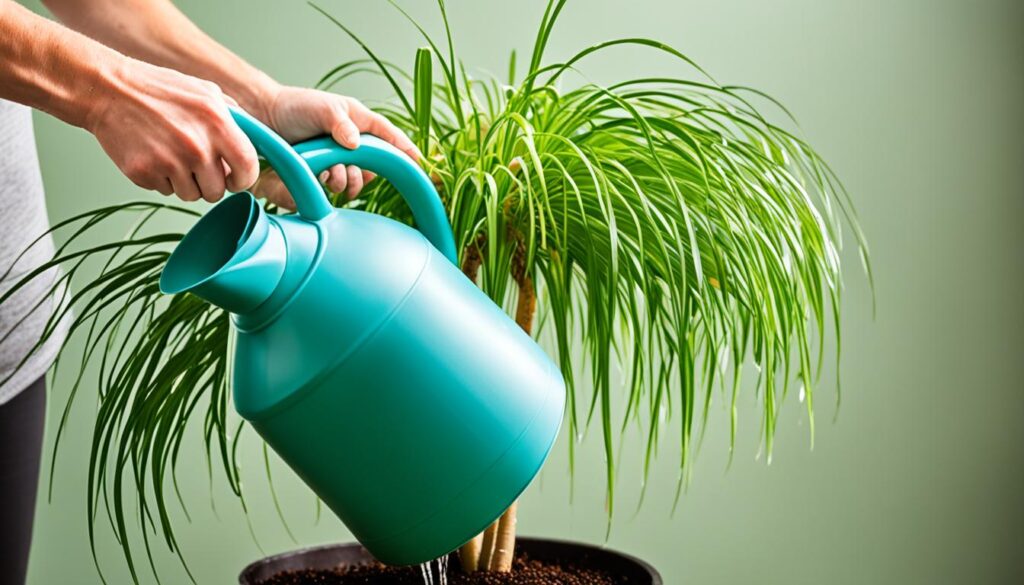
Fertilizing a Ponytail Palm
Recommended Fertilizer for a Ponytail Palm
The Ponytail Palm is easy to take care of. It does not need much fertilizer. But, feeding it sometimes helps it grow better. Use a balanced, water-soluble fertilizer to keep it healthy.
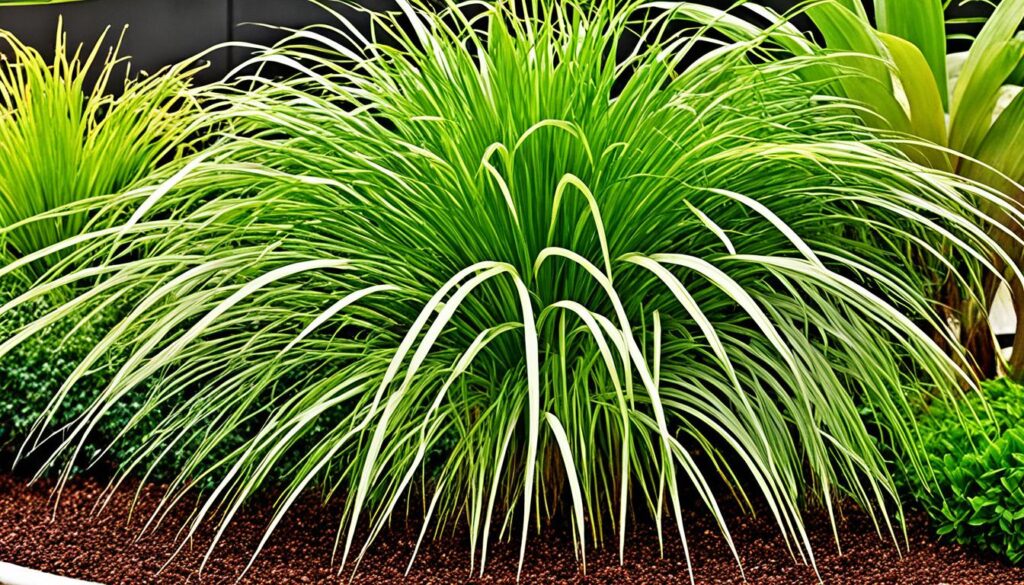
Use a balanced fertilizer that has an NPK ratio of 10-10-10 or 20-20-20. NPK means nitrogen, phosphorus, and potassium. This mix gives your plant all it needs equally.
Always follow the directions on the fertilizer package. Too much can harm your Ponytail Palm. It’s best to fertilize it every 2 to 3 months when it’s growing fast. This is usually from spring to early fall.
| Fertilizer Type | Usage Instructions |
|---|---|
| Water-soluble balanced fertilizer | Dissolve the fertilizer in water as the package says. Put the mix in the soil, not on the leaves. |
Fertilizing helps your Ponytail Palm stay healthy and look great. But, don’t fertilize too much to avoid harm. Check the soil often. Change how you water and fertilize based on what the plant needs. This helps your Palm thrive.
Potting a Ponytail Palm
It’s super important to pot your Ponytail Palm the right way. I’ll show you how to pick the right pot size, use the best potting mix, and repot when needed.
Choosing the Right Pot Size
Find a pot for your Ponytail Palm that’s a bit bigger than its current one. A pot 1-2 inches larger in diameter is good. This gives space for the plant to grow.
Make sure the pot has drainage holes, too. These holes stop water from collecting at the bottom. That way, your plant won’t get root rot.
Using the Right Potting Mix for a Ponytail Palm
Use a potting mix that drains well for your Ponytail Palm. A mix for succulents or cacti is perfect. Such mixes have things like perlite or sand to help drain water.
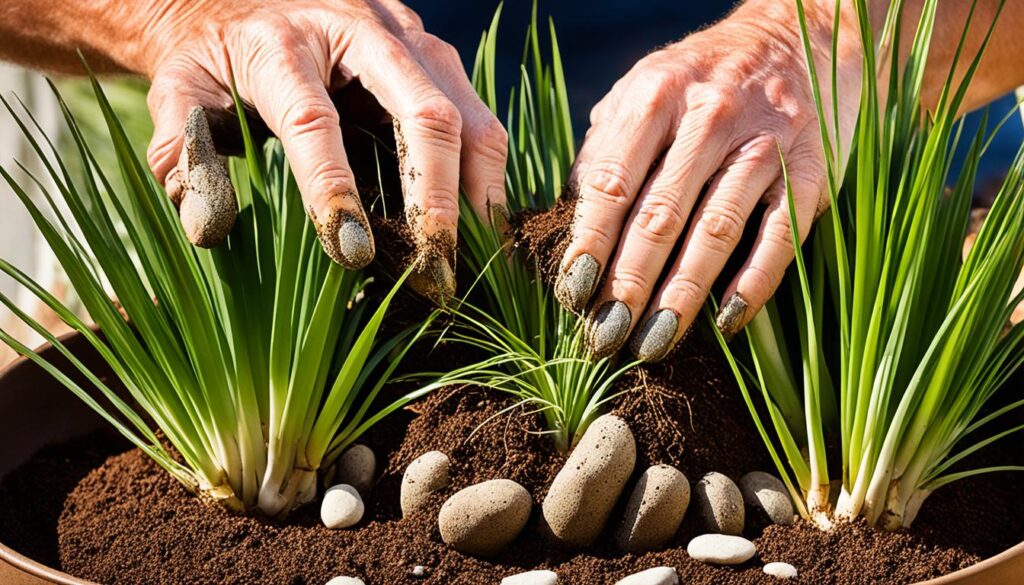
Repotting When Necessary
Sometimes, you’ll need to repot your Ponytail Palm. Doing this every 2-3 years is usually enough.
Take your plant out gently to check its roots when repotting. Cut off any bad roots. Then, put it in a new pot with new potting mix. Pick a pot that’s big enough for growth.
After repotting, water your plant well. Put it somewhere it can get enough light. This helps it settle in.
If you follow these steps, your Ponytail Palm will grow well. It will make your space more beautiful.
Propagating a Ponytail Palm
There are many ways to make more Ponytail Palms. You can use stem cuttings or divide the plant. Let’s see how both work:
Stem Cuttings Or Seeds?
Stem cuttings:
Using stem cuttings is a common way to grow new plants. First, find a healthy Ponytail Palm. Cut a part of the stem with clean, sharp shears. Make sure it’s a few inches long. Let the cutting dry for a few days. This stops it from rotting.
Plant the dried cutting in succulent soil about an inch deep. Mist the soil and put it somewhere warm and bright. Keep the soil a bit wet but not too much. Soon, the cutting will root and grow into a new plant.
Seed propagation:
Starting Ponytail Palms from seeds is slower. You need good seeds and patience. Put the seeds in succulent soil and cover them lightly. The pot should stay warm and bright. Keep the soil moist with a spray bottle.
It can take a long time for seeds to sprout. Once they do, make sure they get enough light. Growing from seeds takes years but can be very satisfying.
Division Of A Ponytail Palm
You can also make more plants by dividing them. This means taking the small baby plants from the main one.
To do this, take the Ponytail Palm out of its pot. Look for small baby plants at the base. Carefully take these babies apart from the main plant. Make sure they have roots. Put them in new pots with succulent soil.
Look after these new little plants well. Give them light but not too strong, and water them regularly. They will grow up to be their own Ponytail Palms.
Growth and Development of the Ponytail Palm
The Ponytail Palm is a special plant. It grows slowly. It shows us that patience is key in its growth. In homes, it can grow to be 4-6 feet tall. This makes it perfect for small places. In the wild, it can reach up to 30 feet. The amount of light, warmth, and care affects how fast it grows.
For good growth, the right light is important. It loves bright, indirect light. It can survive in less light. But it does best with lots of light.
Temperature is also key for the Ponytail Palm. It likes to be warm, between 65-85°F. If it gets too hot or too cold, it won’t grow well.
Taking good care of the plant is important. It needs soil that drains water well. Don’t water it too much. Too much water is bad for its roots. Letting the soil dry out a bit before watering helps the plant stay healthy.
It might take years for the Ponytail Palm to fully grow. But as it grows, it makes any room look better.
“The Ponytail Palm is a slow-growing plant that requires patience and careful attention to achieve its full potential. By providing the right conditions and care, you can witness its growth and development over time.”
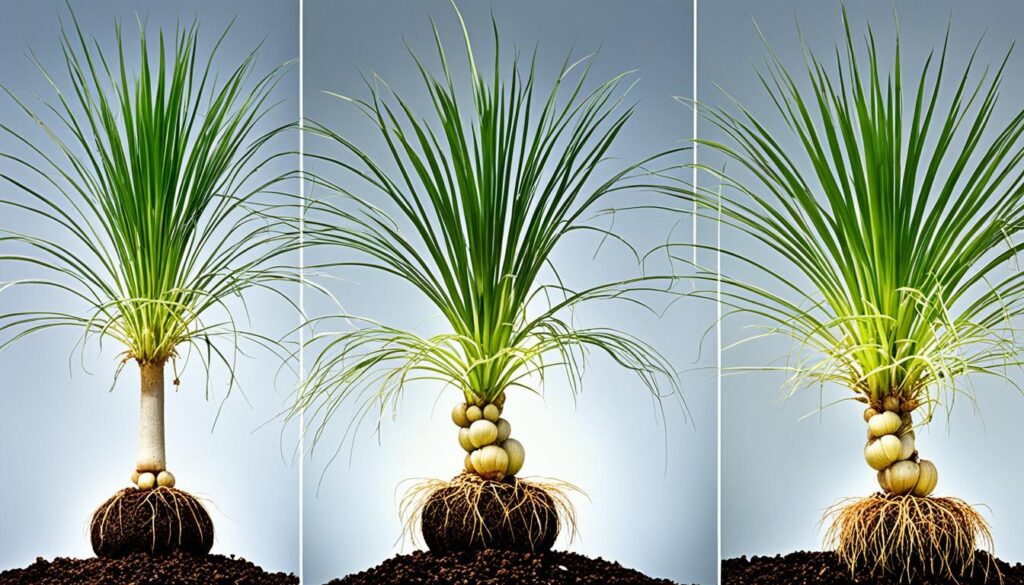
Dealing with Pests and Diseases in the Ponytail Palm
The Ponytail Palm is tough against pests and diseases. But it can still face some common problems. Check it often and treat early for pests and diseases.
Common Pests
The Ponytail Palm may get spider mites, mealybugs, and scale insects. These bugs harm the plant by eating its leaves and stems. It’s important to look for these pests regularly.
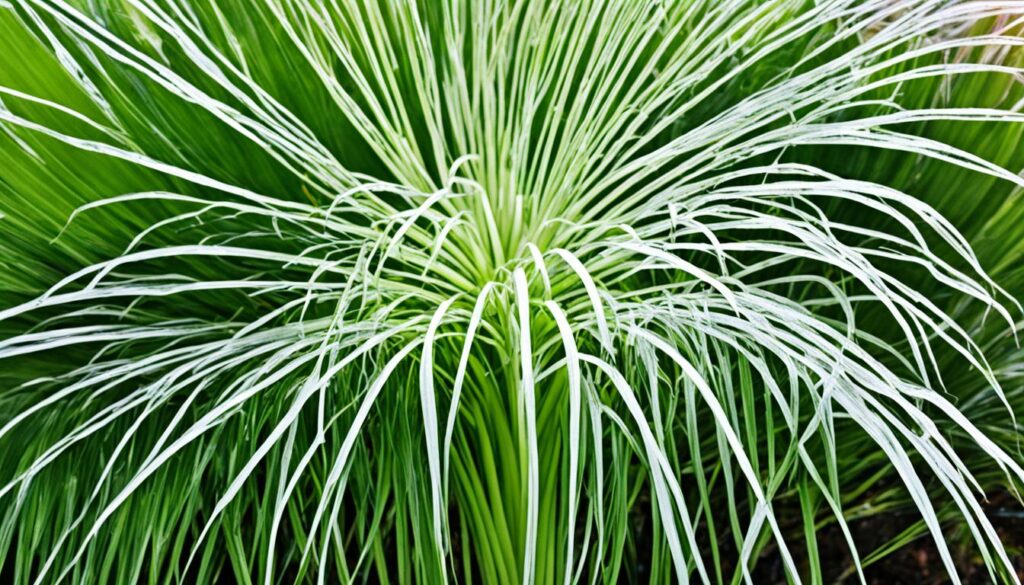
Spider mites are tiny bugs that damage leaves, turning them yellow and creating webs. Mealybugs are small, white bugs found on leaves and stems. They leave a white, sticky mess. Scale insects are tiny, round bugs that stick to the plant. They suck the sap, making the plant wilt and leaves turn yellow.
We must get rid of these pests to keep the Ponytail Palm healthy.
Disease Prevention
The Ponytail Palm might get sick with root rot or fungal issues. This happens if it’s watered too much or in a damp place. To avoid sickness, water it right and make sure air can flow around it well.
By taking these steps, the Ponytail Palm can be healthy and grow well indoors.
Common Ponytail Palm Pests
Ponytail Palms can get sick from different pests. Knowing these pests helps you protect the palm.
Spider mites, mealybugs, and scale insects can harm the plant. They eat its sap and hurt its growth.
Spider Mites: Spider mites are tiny and hard to see. They look like small dots on leaves and make webs. This can turn the leaves yellow. Check your plant often and use special soaps or neem oil to fight them.
Mealybugs: Mealybugs are small bugs that hide under leaves and near the plant’s base. They leave a white, sticky mess that can bring more pests. Clean them with alcohol or soap on a cotton swab.
Scale Insects: Scale insects look like tiny bumps on leaves and stems. They stick to the plant, eat its sap, and cause damage. Cut away really bad parts and use special soaps or oils.
Keep your Ponytail Palm healthy to avoid pests. Check the plant often and take care of any bugs right away. Water, light, and food help keep the plant strong and pest-free.
Next, we’ll look at natural ways to fight these pests and keep your palm healthy.
Natural Predators
The Ponytail Palm might get bugs like other inside plants. But, natural enemies can help.
Ladybugs and other good bugs eat the bad ones on this plant. They eat spider mites and more.
Isolate Infected Plants
See bugs on your Ponytail Palm? Keep it away from your other plants fast.
This stops the bugs from spreading and saves your plants.
Chemical Treatment
Sometimes, you need chemicals to fight the bugs. You might use bug killers or special oils.
Be sure to follow the instructions to use them right. Try to use safe options when you can.
Disease Prevention For Ponytail Palms
Keeping your Ponytail Palms healthy is very important. The right care can make them glow and live long.
Water them right to prevent sickness. Let the soil dry before you water them again. This stops root rot and fungal infections.
They also need good air to stay healthy. Do not put them too close to each other. This helps stop moisture build-up and fungi growth.
Look after your Ponytail Palms well. Check them often for disease or bugs. This way, they stay healthy and beautiful in your home.
Tips for Maintaining Ponytail Palms
Keeping your Ponytail Palms healthy and beautiful is simple. Just do regular care steps. This way, they stay pretty and make your room look nice.
Wiping Leaves
It’s important to clean the leaves often. Dust stops the plants from making food properly. Use a wet cloth to wipe the leaves. This makes the plant look better and stay healthy.
Outdoor Exposure
Ponytail Palms like being indoors but enjoy outside time too. Going outside helps them grow strong. But, bring them out slowly to avoid sunburn. First, put them in the shade, then move to a place with some sun.
Adjusting Watering Schedule
Changing how often you water your palm is key. It needs different amounts of water in each season. Ponytail Palms like to dry out before getting more water. This stops the roots from rotting. Check the soil and water it when the top inch is dry.
Tips for Successful Overwintering of Ponytail Palm
It’s key to keep your Ponytail Palm safe in winter. Here are easy steps to make sure your plant stays happy:
- Put your plant in a warm spot. Make sure it’s not near cold windows or places with cold air.
- It needs good light. Even if Ponytail Palms don’t need a lot of light, make sure it gets enough. A spot near a window works well for this.
- Water it less in winter. Because it grows slower and gets less light, it needs less water. Make sure the soil gets a bit dry before you water it again.
With these steps, your Ponytail Palm will stay healthy and look good all winter.
Growing Ponytail Palm from Seed
Growing a Ponytail Palm from seed takes patience and time. It’s rewarding to see your plant grow from the start.
To begin, get quality Ponytail Palm seeds from a trusted place. Then, you can start germination.
Choose a well-draining succulent mix for potting. Use a small, shallow container and lightly wet it. Ensure the container has holes to drain water and avoid rot.
Then, scatter the seeds on the potting mix. Space them well. Cover them lightly with a thin layer of mix, about 1/8 inch deep.
To germinate, seeds need warmth and humidity. Cover the container with plastic wrap or use a clear plastic bag. This makes a mini greenhouse.
Place the container in a bright area but away from direct sun. Direct sunlight can dry the mix too fast.
Waiting for germination requires weeks to months. Be patient. After sprouting, keep giving warmth and humidity.
As seedlings grow, start to expose them more to light by removing the plastic. This helps them get used to normal light.
Move the seedlings to individual pots with good soil when they have a few leaves. Be gentle to not hurt their roots.
Growing these palms from seeds is slow. It could take years for full growth. Still, it’s rewarding to watch them grow from seeds.
Varieties of Ponytail Palm
The Ponytail Palm is known as Beaucarnea recurvata or Elephant Foot Plant. It has many types that make plant lovers happy. You can pick one that you like. It also makes your indoor plants more diverse.
There are common types like Beaucarnea recurvata, Beaucarnea gracilis, and Beaucarnea guatemalensis. Even though they are similar in care, they look different. For instance, Beaucarnea gracilis leaves are slimmer than those of Beaucarnea recurvata.
There are special cultivars of the Ponytail Palm too. They show unique features or looks. This means you can have a very special plant. The Ponytail Palm will make your indoor place look like a tropical paradise.

